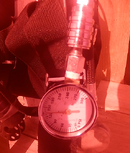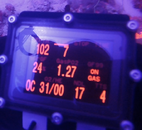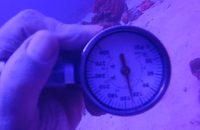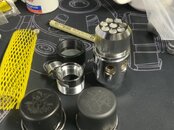Some early titanium regs caught fire, and Atomic wanting to be the best and offer their flagship titanium reg went to Monel to make their reg pass the fire tests. Apparently they keep the fire from spreading, but I think/guess the reg would still need expensive service and would not be diveable after a fire. Not sure if a Mk11T would catch fire. Prevention is paramount, and most regs taching fire would be trouble. Personally I'd keep nitrox below 30% in any titanium reg, and keep the reg clean.
You are using an out of date browser. It may not display this or other websites correctly.
You should upgrade or use an alternative browser.
You should upgrade or use an alternative browser.
Mk11 Split-off from Regulator Geeks, Part II
- Thread starter -JD-
- Start date
Please register or login
Welcome to ScubaBoard, the world's largest scuba diving community. Registration is not required to read the forums, but we encourage you to join. Joining has its benefits and enables you to participate in the discussions.
Benefits of registering include
- Ability to post and comment on topics and discussions.
- A Free photo gallery to share your dive photos with the world.
- You can make this box go away
Geo7
Contributor
Not sure there has ever been a fire with 32% ? So it's probably ok if the reg is kept clean (no rust inside, no old sinter filter, regular service using ultrasonic, etc). Titanium does not make a fire more likely, it just reacts more to it. I think the old Atomics before Monel were already certified for 30% nitrox if I remember correctly. And the elephant in the room is the diaphragm in all such regs, and plenty of those are certified for more than 30% nitrox. In case of a fire the diaphragm would burn instantly and release all the gas, titanium or not.I was getting mostly 32% in Cozumel with no option on the mix.
Oops, we are derailing the thread!
Andrew Dawson
Contributor
one can always look at insane alternatives, like the MK 21 and siliconeView attachment 713141View attachment 713142View attachment 713143
Gorgeous!! I have been given/lent some DIY SPEC boots for MK20/25 regs. I am considering a boot that acts more like a filter/strainer. That is, a permeable barrier covering the ambient chamber ports that allows clean water in/out, very little debris gets in, and allows for pressure changes to affect the piston for balancing the reg. This would be done without packing the ambient chamber with grease....however, after each dive, one must fold the boot off of the ports and flush with freshwater.
This method will be easier than having to pack the ambient chamber with grease and having to deal with that mess during rebuilds...even though rebuilds would be less frequent going forward.
Thoughts?
SP did this years ago. There were kits that had sintered filters in the ambient chamber of MK2/5/7 first stages. However, that was after packing with silicone grease. I would not trust a sintered filter to allow only "clean water in" as it would hold water in the chamber-much easier to pack with grease and install (or not if using silicone) a boot.That is, a permeable barrier covering the ambient chamber ports that allows clean water in/out, very little debris gets in, and allows for pressure changes to affect the piston for balancing the reg.
Edit: There was a MK2 "Environ" in the classifieds a while back:
Closed - Mk2/r108 dive rite bar spg
Scubapro mk2 w cold water kit and r108, w dive rite bar spg. Would be great for a pony bottle or bail out set. No leaks but should be serviced before use. $100 shipped.
@-JD- I'd think pretty much so. Which should be little to never.. What I have run into is the "old" coating on my MK20/25 pistons is failing and is a gummy mess. The "new" blue ones (it that is what you get" are likely to last a good long time...
Keep in mind, the MK20 ones I have are likely 30 years old.....
Keep in mind, the MK20 ones I have are likely 30 years old.....
That could work to negate the grit problem, I assume you are helping James in the MK 25 boot project. The MK 21 is very easy to pack with grease compared with a MK 20/25 but it’s less than ideal for a boot to behave properly by providing a containment Reservoir for the grease so I’m using the band you see mostly to contain any mess while the grease moves in and out of the holes, so for it’s working well up to 50 feet, I plane to try in deeper in curaçao next month, also considering a waterproof ip gauge to track it with varying depths.Gorgeous!! I have been given/lent some DIY SPEC boots for MK20/25 regs. I am considering a boot that acts more like a filter/strainer. That is, a permeable barrier covering the ambient chamber ports that allows clean water in/out, very little debris gets in, and allows for pressure changes to affect the piston for balancing the reg. This would be done without packing the ambient chamber with grease....however, after each dive, one must fold the boot off of the ports and flush with freshwater.
This method will be easier than having to pack the ambient chamber with grease and having to deal with that mess during rebuilds...even though rebuilds would be less frequent going forward.
Thoughts?
I'm terrible at editing videos, so I'll attempt to attach a few screen shots of the IP of my packed MK10 with @James79 's boot. At the surface IP was 135psi. At 102 feet it was the same. (Bonaire this past summer)
Attachments
I am considering a boot that acts more like a filter/strainer. That is, a permeable barrier covering the ambient chamber ports that allows clean water in/out, very little debris gets in, and allows for pressure changes to affect the piston for balancing the reg. This would be done without packing the ambient chamber with grease....however, after each dive, one must fold the boot off of the ports and flush with freshwater.
Thoughts?
You could always go the route of Poseidon and their rubber antifreeze caps, which we frequently used as an environmental barrier, in questionable water, regardless of the temperature (usually recommended for 6˚C and colder). Sometimes, collecting samples in harbors, was analogous to swimming through thinned chocolate pudding; and you wouldn't believe the amount of crap that would accumulate, within the "secondary chamber” and require a serious hosing.
The caps didn't have to be filled, while in shallow water, since they were readily compressible; though Poseidon recommended either vodka or a glycerin / alcohol mixture, for any dives at or below 40 meters, when the caps would otherwise be so compressed and the regulator, frighteningly -- according to the old manual -- rendered no longer breathable. I took down "empty" antifreeze caps, to about 30 meters, without any noticeable breathing issues, since the small amount of trapped, compressed air inside, allowed for sufficient “compensation.”
The other, more involved version (see photo), which was also used for years, included a vented metal or Delrin cap, fitted with a replaceable diaphragm, over a new assembly which replaced the entire top of the regulator, including the adjustment screw. The IP had to be wholly reset with the new parts, and the chamber filled with a 1:1 glycerin / alcohol mixture. The vented cap was then placed on top -- and its seated membrane contained the antifreeze fluid and effectively isolated it from the surrounding water . . .
Attachments
ElegantYou could always go with the technique of Poseidon and their rubber antifreeze caps, which we frequently used as an environmental barrier, in questionable water, regardless of the temperature. Sometimes, collecting samples in harbors, was akin to swimming in thin chocolate pudding; and you wouldn't believe the crap that would accumulate, within the "secondary chamber."
They didn't even have to be filled with anything at all, while in shallow water, since they were readily compressible; though Poseidon recommended vodka or a glycerin / alcohol mixture, for any dives below 40 meters, when they would be compressed so as to be no longer functional. I took down "empty" antifreeze caps, to about 30 meters, without any noticeable effect, since the trapped air inside, allowed for sufficient compensation.
The other, more involved version (see photo), which was used for years, included a vented metal or Delrin cap, fitted with a diaphragm, over an assembly which replaced the entire top of the regulator, including the adjustment screw. The IP had to be reset with the new assembly and the chamber filled with a 1:1 glycerin / alcohol mixture. The vented cap was then placed on top -- and its membrane contained the antifreeze fluid and isolated it from the outside waters . . .
Andrew Dawson
Contributor
You could always go the route of Poseidon and their rubber antifreeze caps, which we frequently used as an environmental barrier, in questionable water, regardless of the temperature (usually recommended for 6˚C and colder). Sometimes, collecting samples in harbors, was analogous to swimming through thinned chocolate pudding; and you wouldn't believe the amount of crap that would accumulate, within the "secondary chamber” and require a serious hosing.
The caps didn't have to be filled, while in shallow water, since they were readily compressible; though Poseidon recommended either vodka or a glycerin / alcohol mixture, for any dives at or below 40 meters, when the caps would otherwise be so compressed and the regulator, frighteningly -- according to the old manual -- rendered no longer breathable. I took down "empty" antifreeze caps, to about 30 meters, without any noticeable breathing issues, since the small amount of trapped, compressed air inside, allowed for sufficient “compensation.”
The other, more involved version (see photo), which was also used for years, included a vented metal or Delrin cap, fitted with a replaceable diaphragm, over a new assembly which replaced the entire top of the regulator, including the adjustment screw. The IP had to be wholly reset with the new parts, and the chamber filled with a 1:1 glycerin / alcohol mixture. The vented cap was then placed on top -- and its seated membrane contained the antifreeze fluid and effectively isolated it from the surrounding water . . .
If I am making a big of a change such as swapping entire regulator systems, I need not worry about a DIY boot...I will just switch to environmentally sealed SM regs like MK19 or similar from Deep Six.
I am going to see what I can come up with...maybe use the silicone SPEC boot prototypes and figure out some sort of durable synthetic mesh....just a filter or sorts for the ports
Similar threads
- Replies
- 16
- Views
- 3,873
- Replies
- 24
- Views
- 4,425
- Replies
- 39
- Views
- 7,145
- Replies
- 10
- Views
- 1,459
- Replies
- 5
- Views
- 1,071







